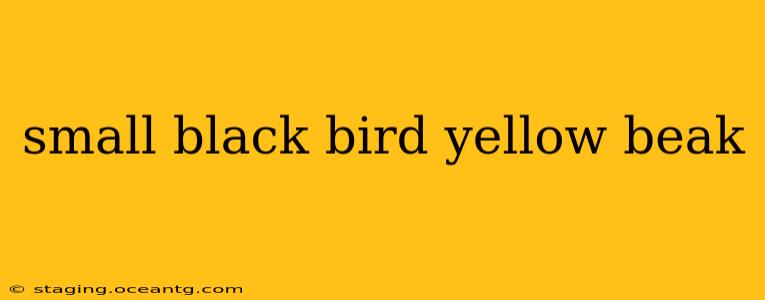Spotting a small, black bird with a bright yellow beak can be intriguing! Many species fit this description, making identification a bit of a challenge. This guide will help you narrow down the possibilities, providing crucial details to aid your birdwatching endeavors. We’ll explore several common species and the key features that distinguish them. Remember to note the bird's size, habitat, location, and any additional markings for the most accurate identification.
What are some small black birds with yellow beaks?
This is a great starting point! Several bird species share these characteristics, but their geographic location plays a significant role in identification. Some of the most common possibilities include:
-
American Goldfinch (Spinus tristis): While not entirely black, the male American Goldfinch boasts bright yellow wings and a vibrant yellow beak. They are small, active birds often seen in flocks, feeding on seeds. Their plumage varies throughout the year; the breeding males are the most strikingly colored.
-
Yellow-rumped Warbler (Setophaga coronata): This warbler features a yellow rump, as its name suggests, and a generally yellowish beak. While not entirely black, it has dark olive-colored upperparts and can appear predominantly dark from a distance.
-
Black-headed Grosbeak (Pheucticus melanocephalus): The adult male Black-headed Grosbeak displays a striking black head and chest, contrasted by a bright yellow beak. They're larger than the previous examples and possess a hefty bill. Females, however, are significantly different in appearance, with brown-streaked bodies.
What size is a small black bird?
"Small" is relative, so providing a size comparison helps significantly. Consider comparing the bird's size to common objects like a sparrow, a hummingbird, or even your hand. Is it smaller than a sparrow? About the same size? Slightly larger? This information is crucial for narrowing down possibilities.
Where did you see the small black bird with a yellow beak?
The bird's location is a pivotal piece of the puzzle. Different species inhabit specific regions and habitats. Knowing whether you saw the bird in a forest, a field, a suburban garden, or near a body of water significantly aids identification. For instance, certain species prefer coniferous forests, whereas others thrive in open grasslands.
What other identifying features did the small black bird have?
Beyond the basic black plumage and yellow beak, what other details did you notice? This might include:
- Head markings: Are there any distinctive markings on its head, such as a crest, streaks, or patches of different colors?
- Body markings: Does it have any white markings, stripes, or other noticeable variations in its plumage?
- Tail shape and length: Is the tail long or short? What shape is it?
- Behavior: What was the bird doing? Was it foraging on the ground, flitting through trees, or singing a particular song?
These additional details greatly increase the accuracy of identification.
Are there any pictures or videos of the bird?
If you managed to capture a picture or video, that's a goldmine of information! Sharing these images with online bird identification communities or using bird identification apps can provide quick and accurate results.
What are some resources for identifying birds?
There are many excellent resources available for bird identification:
- Field guides: Regional field guides are invaluable for identifying birds based on their location.
- Bird identification apps: Apps like Merlin Bird ID or iNaturalist use image recognition to assist with identification.
- Online bird communities: Online forums and social media groups dedicated to birdwatching offer a space to share images and receive assistance from experienced birders.
By carefully observing and recording the bird’s features and using the available resources, you’ll be well on your way to accurately identifying that small black bird with the striking yellow beak! Remember, accurate identification takes time and practice, but the rewarding feeling of successfully identifying a bird is well worth the effort.
